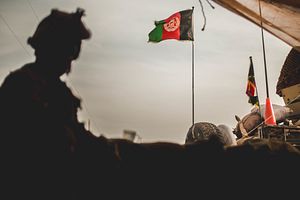Defying threats, deep security concerns, and possible vote rigging, Afghanistan held successful parliamentary elections this past weekend, once again proving a commitment and belief in the power of democracy and the ballot box.
Due to technical and organizational problems in some polling centers, voting was delayed. However, overall, the election was a success. The Election Commission of Afghanistan gave a one day extension in the constituencies where there were technical glitches or delay in the opening of polls.
More than 2,500 candidates ran to secure seats in the 249-member lower house of parliament. The candidates were a diverse crowd: From warlords to journalists, entrepreneurs, government employees, nomads, minority groups, and women, and many of them young. While there were many new faces, others were linked to familiar political groups and factions, many based on ethnic loyalties.
Some of the warlords, politicians, and a few current parliament members brought their children to the forefront to run for election. Among them were the sons of Mohammad Mohaqiq, second deputy to Chief Executive Officer Abdullah Abdullah ; Hizb-e-Islami leader Gulbuddin Hekmatyar; Vice President General Abdul Rashid Dostum; Abdul Rab Rasool Sayaf; and others.
Women’s rights have been a priority for international donors but remain a challenging subject for the Afghan government and political ecosystem. The Afghan constitution guarantees 27 percent of total seats for women parliamentarians, regardless of their vote share. The previous parliament did not give a vote of confidence to the first woman candidate for the Supreme Court introduced by the government. Similarly, among the 11 ministers which were introduced to parliament in 2018, the only candidate that failed to get a vote of confidence was a woman candidate. The hope this time is that women candidates will exceed the 27 percent quota and thus have a stronger voice in the crafting of legislation in the country.
About 8.8 million people were registered to vote ahead of the election — 64 percent of which were men and 34 percent were women. The remaining voters registered as Kochis (nomads), Sikhs, and Hindus.
This is Afghanistan’s third parliamentary election since the Taliban were removed in 2001. The elections were supposed to be held in 2015 when the current assembly’s five-year term ended. But the 2014 presidential election standoff and political crisis pushed the elections back repeatedly.
Past Afghan elections have been marred by corruption, rigging, and fraud; this election is not an exception. That said, however, measures had been put in place by the government to try and prevent fraud and rigging. The government equipped polling stations with biometric identification systems to prevent double voting. More than 20,000 handheld devices were distributed in order to scan fingerprints and pictures.
The latest polls are important for several reasons. Most importantly, they are seen as a test ahead of the next presidential election, scheduled for April 2019. Meanwhile, the parliamentary polls come amid a series of attacks by the Taliban and Islamic State across the country. Furthermore, the latest elections are the first since the NATO combat mission ended in December 2014, making securing the polls a major test for the Afghan security forces. More than 70,000 security forces deployed to maintain the security of the electoral process.
The Taliban and Islamic State condemned the elections and urged people to boycott the polls. At least 10 parliamentary candidates were killed in separate attacks in the lead-up to the election. At least two more candidates were kidnapped.
The elections, intended to be nationwide, were held in 32 of Afghanistan’s provinces. The vote in Ghazni and Kandahar was delayed.
Afghanistan’s elections commission postponed the election in Kandahar province for a week, following a deadly attack that killed renowned police chief General Abdul Raziq along with the province intelligence chief Abdul Momin and two policemen. The Kandahar governor, and three coalition members were injured.
Elections did not take place in Ghazni province either, largely due to a dispute over how to divide its electoral constituencies and provide balanced ethnic representation. In the last election, the minority Hazaras won all the seats from Ghazni, leaving the majority Pashtuns and Tajiks without representation.
Despite prevailing risks, the Afghan people nevertheless proved their desire and capability in holding parliamentary elections. This is a clear message for the Taliban — who are engaged in peace talks directly with the United States — that Afghanistan institutions are functioning and people have marshalled their belief in democracy. If the Taliban wants to be part of the society, they need to win the hearts and minds of people so that they can win their share of power through ballots not bullets.
Ahmad Shah Katawazai, an Afghan diplomat and security expert has a Masters degree in international relations and a second Master’s in Global Security Studies from Johns Hopkins University. Katawazai is a member of the Academy of Sciences of Afghanistan and has work experience with government and international organizations. Follow him on Twitter at @askatawazai.

































